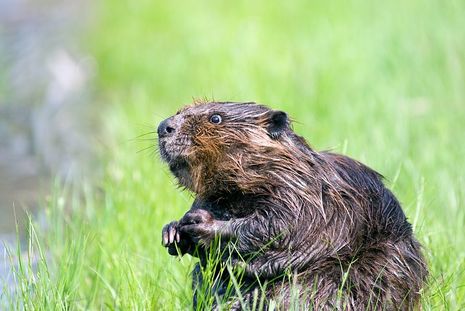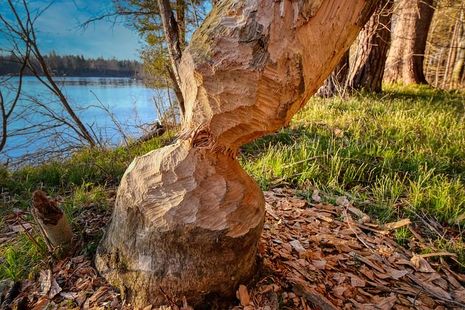The Trials and Tribulations of Beavers in Scotland: A Species of the Times
Coreen Grant takes us on a rollercoaster ride through the forgotten history of beavers on the British isles: from near-extinction to a challenging modern re-introduction, these crucial ecosystem engineers have had it rough and need our support more than ever.

For thousands of years, the Eurasian beaver (Castor fiber) played a key role in the diverse cast of British wildlife. After being hunted to extinction, it was successfully returned to Scotland, the first mammal to be officially reintroduced in the U.K. However, a recent report has revealed a high number of beaver killings as a result of licenses granted to farmers and landowners. Unresolved, the tensions between agriculturalists and conservationists could leave the future of beavers – and biodiversity efforts as a whole – in Britain uncertain.
“In the early 1990s the state of beavers began to change across 25 European countries. The UK, however, was not one of them.”
Beavers are a highly valued species for their contribution as ‘ecosystem engineers’, or more specifically, ‘allogenic’ engineers. This designation refers to their ability to manipulate their environment, physically transforming the landscape from one state to another. By converting trees into timber for dams, beavers radically alter the make-up of woodland meadows and streams, creating new wetland habitats. These habitats, in turn, can bring a multitude of benefits to other species, from mammals such as otters, water shrews and voles, to birds, breeding fish and invertebrates. Non-animal species benefit, too: thinning out older trees allows young saplings to grow. Beavers perform a range of ecosystem services, including filtering silt and pollution from water, reducing risks of downstream flooding, and increasing water retention. Their natural activities, such as coppicing, feeding, and dam-building, have been proven to increase the overall health and resilience of their environment: they are a keystone species within their ecosystem.
During the sixteenth century, beavers in Britain were hunted to extinction for their fur, meat and castoreum (the fluid contained in scent glands, used for perfumes and flavouring). More widely across Europe and North America, beaver populations teetered alarmingly close to extinction: at the turn of the 20th century, numbers in Europe hovered at just over one thousand animals. In the early 1990s, the state of beavers began to change, with more than 200 reintroduction projects taking place across 25 European countries. The U.K., however, was not one of them.
In 1995, Scottish Natural Heritage (SNH) set out to build a case for the reintroduction of beavers to Scotland. Their first application for a reintroduction licence, based on decades of research and independent scientific monitoring, was rejected on the grounds of impact to protected areas of woodland, and an insufficient exit strategy should the trial fail. It was not until 2008 that reintroduction gained government approval. The Scottish Beaver Trial, run by the Scottish Wildlife Trust with project partners the Royal Zoological Society of Scotland and Forestry and Land Scotland, began a five-year trial reintroduction of wild Norwegian beavers in 2009, after over 400 years of absence in Scotland. This resulted in a healthy population in Knapdale Forest, Argyll, a complex landscape of waterways and wooded slopes where the loch systems help keep the trial population in one place. In addition, an unofficial population thrived in Tayside, which had grown following escapes and illegal releases from private collections.
“If lethal control continues at this level, we would have grave concerns for the future of beavers in Scotland.”
After a quarter century of dedicated work, beavers in Scotland achieved European Protected Species Status on 1 May 2019, a milestone in British conservation. At the time, Jo Pike, Chief Exec of Scottish Wildlife Trust, said, ‘I think this moment represents making the impossible possible. Now, more than ever, it’s vital that people see and believe that change can take place’.

The jubilation was not to last. A report released by SNH in May 2020 revealed that following the announcement of species protection, a total of 42 licences for ‘population control’ were issued to farmers and landowners in the remainder of 2019. These licenses resulted in the death of at least 87 beavers, a number representing roughly one fifth of Scotland’s total population, estimated to be under 450 animals. Around ten of the animals killed were thought to be kits less than a year old, while others were left where they were shot for passers-by to find.
The Scottish Wildlife Trust confirmed the level of killings to be ‘alarming’ and ‘deeply concerning’: Sarah Robinson, the Trust’s conservation director, stated that ‘if lethal control continues at this level, we would have grave concerns for the future of beavers in Scotland’. So how did this level of killing come to take place?
“Despite outrage over the killings, the National Farmers Union has claimed that the current management system should remain.”
After summer 2019, the Scottish Beavers Reinforcement Project declared they would prioritise a management framework to accompany the new legal protection. It aimed to carefully balance protection and extension of the beavers’ range, with the understanding that in some cases, land managers would need to deal with localised negative impacts such as flooding. Control methods, including dam removal and translocation, were encouraged as the preferred actions. Anyone seeking a licence to kill was required to attend training sessions, and Pike stated that the Trust would work to ‘ensure that lethal control is only ever used as a last resort – and only in exceptional circumstances’.
Yet the Scottish Government recently confirmed that half of the licenses issued in 2019 were granted without a site visit being conducted, increasing the risk of lethal control where non-lethal options could have been employed. James Nairne, a trustee of the Scottish Wild Beaver Group, said the 2019 killings have undermined the government’s claim to champion wildlife diversity, and constitute ‘a pretty shameful policy failure’. In the Tayside area, potential conflict between beavers and prime agricultural land is high. Although the general public have been largely supportive of reintroduction efforts, there has been a considerable amount of hostility and suspicion from landowners and estates from the beginning of the project. The coming-to-light of the report has highlighted these tensions: despite outrage over the killings, the National Farmers Union in Scotland has claimed that the current management system is effective and should remain.
Robbie Kernahan, Head of Wildlife Management with SNH, insisted that licenses to kill remain a last resort: ‘we can be comfortable this level of off-take is sustainable and is not actually having any detrimental impact on the conservation status’. Yet it remains to be seen why lethal control was granted to such an extent, when other methods have proven successful. Only last year, fifteen beavers were successfully trapped and transported from lower Tayside to more desirable locations, some bolstering the official population in Knapdale and the rest moved to England, where support for reintroduction is growing.
After protected status was achieved in 2019, Pike stated that the reintroduction of beavers was about ‘restoring the balance of nature that we have thrown so badly off-course – and reappraising how we live alongside species other than ourselves.’ It seems that now, in light of the report, a new reappraisal is needed if we are to retain beavers as a prospering part of our natural environment. In a wider perspective of climate emergency, in which the effects of a chronic decline in biodiversity are becoming increasingly apparent, the precarious future of beavers in Scotland highlights larger questions about our priorities going forward.
 News / Cambridge academics stand out in King’s 2026 Honours List2 January 2026
News / Cambridge academics stand out in King’s 2026 Honours List2 January 2026 Comment / Plastic pubs: the problem with Cambridge alehouses 5 January 2026
Comment / Plastic pubs: the problem with Cambridge alehouses 5 January 2026 News / Cambridge businesses concerned infrastructure delays will hurt growth5 January 2026
News / Cambridge businesses concerned infrastructure delays will hurt growth5 January 2026 News / AstraZeneca sues for £32 million over faulty construction at Cambridge Campus31 December 2025
News / AstraZeneca sues for £32 million over faulty construction at Cambridge Campus31 December 2025 Interviews / You don’t need to peak at Cambridge, says Robin Harding31 December 2025
Interviews / You don’t need to peak at Cambridge, says Robin Harding31 December 2025









